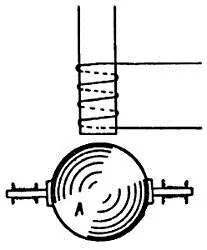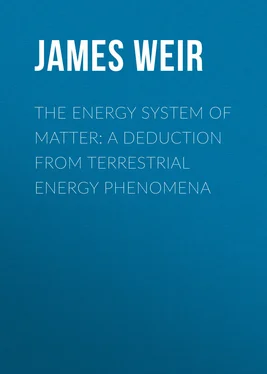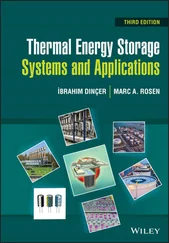James Weir - The Energy System of Matter - A Deduction from Terrestrial Energy Phenomena
Здесь есть возможность читать онлайн «James Weir - The Energy System of Matter - A Deduction from Terrestrial Energy Phenomena» — ознакомительный отрывок электронной книги совершенно бесплатно, а после прочтения отрывка купить полную версию. В некоторых случаях можно слушать аудио, скачать через торрент в формате fb2 и присутствует краткое содержание. Жанр: foreign_antique, Физика, foreign_edu, на английском языке. Описание произведения, (предисловие) а так же отзывы посетителей доступны на портале библиотеки ЛибКат.
- Название:The Energy System of Matter: A Deduction from Terrestrial Energy Phenomena
- Автор:
- Жанр:
- Год:неизвестен
- ISBN:нет данных
- Рейтинг книги:3 / 5. Голосов: 1
-
Избранное:Добавить в избранное
- Отзывы:
-
Ваша оценка:
- 60
- 1
- 2
- 3
- 4
- 5
The Energy System of Matter: A Deduction from Terrestrial Energy Phenomena: краткое содержание, описание и аннотация
Предлагаем к чтению аннотацию, описание, краткое содержание или предисловие (зависит от того, что написал сам автор книги «The Energy System of Matter: A Deduction from Terrestrial Energy Phenomena»). Если вы не нашли необходимую информацию о книге — напишите в комментариях, мы постараемся отыскать её.
The Energy System of Matter: A Deduction from Terrestrial Energy Phenomena — читать онлайн ознакомительный отрывок
Ниже представлен текст книги, разбитый по страницам. Система сохранения места последней прочитанной страницы, позволяет с удобством читать онлайн бесплатно книгу «The Energy System of Matter: A Deduction from Terrestrial Energy Phenomena», без необходимости каждый раз заново искать на чём Вы остановились. Поставьте закладку, и сможете в любой момент перейти на страницу, на которой закончили чтение.
Интервал:
Закладка:
Another point of some importance which will be revealed by the study of secondary operations is that every energy process has in some manner definite energy limits imposed upon it. In the workings of mechanical or "work" energy it is the mass value of the moving material which, in this respect, is important. The mass, in fact, is the real governing factor of the whole process (§ 20). It determines the maximum amount of energy which can be applied to the material, and thus controls the extent of the energy operation.
But in actions involving the molecular energies, the operation may be limited by other considerations altogether. For example, the application of heat to a solid body gives rise to certain energy processes (§ 27). These processes may proceed to a certain degree with increase of temperature, but a point will finally be attained where change of state of the heated material takes place. This is the limiting point of this particular operation. When change of state occurs, the phenomena will assume an entirely different aspect. The first set of energy processes will now be replaced by a set of operations absolutely different in nature, themselves limited in extent, but by entirely different causes. The first operation must thus terminate when the new order appears. In this manner each process in which the applied energy is worked will be confined within certain limiting boundaries. In any chain of energy operations each link will thus have, as it were, a definite length. In chemical reactions, the limits may be imposed in various ways according to the precise nature of the action. Chemical combination, and chemical disruption, must be looked on as operations which involve not only the transformation of energy but also the transformation of matter. In most cases, chemical reactions result in the appearance of matter in an entirely new form—in the appearance, in fact, of actually different material, with physical and energy properties absolutely distinct from those of the reacting constituents. This appearance of matter in the new form is usually the evidence of the termination, not only of the particular chemical process, but also of the energy process associated with it. Transformation of energy may thus be limited by transformation of matter.
Examples of the limiting features of energy operations could readily be multiplied. Even a cursory examination of most natural operations will reveal the existence of such limits. In no case do we find in Nature any body, or any energy system, to which energy may be applied in unlimited amount, but in every case, rigid energy limits are imposed, and, if these limits are exceeded, the whole energy character of the body or system is completely changed.
14. Incepting Energy Influences
In experimental and in physical work generally, it has been customary, in describing any simple process of energy transformation, to take account only of those energies or those forms of energy which play an active part in the process—the energy in its initial or applied form and the energy in its transformed or final form. This method, however, requires enlarging so as to include another feature of energy transformation, a feature hitherto completely overlooked, namely, that of incepting energy. Now, this conception of incepting energy, or of energy as an incepting influence, is of such vital importance to the author's scheme, that it is necessary here, at the very outset, to deal with it in some detail. To obtain some idea of the general nature of these influences, it will be necessary to describe and review a few simple instances of energy transformation. One of the most illuminating for this purpose is perhaps the familiar process of dynamo-electric transformation.
A spherical mass A ( Fig. 1) of copper is caused to rotate about its central axis in the magnetic field in the neighbourhood of a long and powerful electro-magnet. In such circumstances, certain well-known transformations of energy will take place. The energy transformed is that dynamical or "work" energy which is being applied to the spherical mass by the external prime mover causing it to rotate. As a result of this motion in the magnetic field, an electrical action takes place; eddy currents are generated in the spherical mass, and the energy originally applied is, through the medium of the electrical process, finally converted into heat and other energy forms. The external evidence of the process will be the rise in temperature and corresponding expansion of the rotating mass.

Fig. 1
Such is the energy transformation. Let us now review the conditions under which it takes place. Passing over the features of the "work" energy applied and the energy produced in the transformation, it is evident that the primary and essential condition of the whole process is the presence of the magnetic field. In the absence of this influence, every other condition of this particular energy operation might have been fulfilled without result. The magnetic field is, in reality, the determining agency of the process. But this field of magnetic force is itself an energy influence. Its existence implies the presence of energy; it is the external manifestation of that energy (usually described as stored in the field) which is returned, as shown by the spark, when the exciting circuit of the electro-magnet is broken. The transformation of the dynamical or "work" energy (§ 31) applied to the rotating sphere is thus carried out by the direct agency, under the power, or within the field of this magnetic energy influence, to which, accordingly, we apply the expression, incepting energy influence, or incepting energy.
There are several points to be noted with regard to these phenomena of inception. In the first place, it is clear that the energy which thus constitutes the magnetic field plays no active part in the main process of transformation: during the operation it neither varies in value nor in nature: it is entirely a passive agent. Neither is any continuous expenditure of energy required for the maintenance of this incepting influence. It is true that the magnetic field is primarily due to a circulatory current in the coils or winding of the electro-magnet, but after the initial expenditure of energy in establishing that field is incurred, the continuous expenditure of energy during the flow of the current is devoted to simply heating the coils. A continuous heat transformation is thus in progress. The magnetic energy influence, although closely associated with this heat transformation, yet represents in itself a distinct and separate energy feature. This last point is, perhaps, made more clear if it be assumed that, without altering the system in any way, the electro-magnet is replaced by a permanent magnet of precisely the same dimensions and magnetic power. There would then be no energy expenditure whatever for excitation, but nevertheless, the main transformation would take place in precisely the same manner and to exactly the same degree as before. The incepting energy influence is found in the residual magnetism.
If an iron ball or sphere were substituted, in the experiment, for the copper one, the phenomena observed on its rotation would be of an exactly similar nature to those described above. There is, however, one point of difference. Since the iron is magnetic, the magnet pole will now exert an attractive force on the iron mass, and if the latter were in close proximity to the pole ( Fig. 1), a considerable expenditure of energy might be required to separate the two. It is evident, then, that in the case of iron and the magnetic metals, this magnetic influence is such that an expenditure of energy is required, not only to cause these materials to move in rotation so as to cut the lines of the field of the magnetic influence, but also to cause them to move outwards from the seat of the influence along the lines of the field. The movements, indeed, involve transformations of energy totally different in nature. Assuming the energy to be obtained, in both cases, from the same external source, it is, in the first instance, converted by rotatory motion in the field into electrical and heat energy, whereas, in the second case, by the outward motion of displacement from the pole, it is transformed and associated with the mass in the form of energy of position or energy of displacement relative to the pole. Since the attractive force between the iron mass and the pole may be assumed to diminish according to a well-known law, the energy transformation per unit displacement will also diminish at the same rate. The precise nature and extent of the influence of the incepting agent thus depend on the essential qualities of the energised material under its power. In this case, the magnetic metals, such as iron, provide phenomena of attraction which are notably absent in the case of the dia-magnetic metals such as copper. Other substances, such as wood, appear to be absolutely unaffected by any movement in the magnetic field. The precise energy condition of the materials in the field of the incepting influence is also an important point. The incepting energy might be regarded as acting, not on the material itself, but rather on the energy associated with that material. From the phenomena already considered, it is clear that before the incepting influence of magnetism can act on the copper ball, the latter must be endowed with energy of rotation. It is on this energy, then, that the incepting influence exerts its transforming power. It would be useless to energise the copper ball, say by raising it to a high temperature, and then place it at rest in the magnetic field; the magnetic energy influence would not operate on the heat energy, and consequently, no transformation would ensue.
Читать дальшеИнтервал:
Закладка:
Похожие книги на «The Energy System of Matter: A Deduction from Terrestrial Energy Phenomena»
Представляем Вашему вниманию похожие книги на «The Energy System of Matter: A Deduction from Terrestrial Energy Phenomena» списком для выбора. Мы отобрали схожую по названию и смыслу литературу в надежде предоставить читателям больше вариантов отыскать новые, интересные, ещё непрочитанные произведения.
Обсуждение, отзывы о книге «The Energy System of Matter: A Deduction from Terrestrial Energy Phenomena» и просто собственные мнения читателей. Оставьте ваши комментарии, напишите, что Вы думаете о произведении, его смысле или главных героях. Укажите что конкретно понравилось, а что нет, и почему Вы так считаете.












